Types of ThermometerThe invention of the thermometer has become useful for various industries. However, they have been most important for the development of medical practices in the health industry. Thermometers have become an integral tool for properly measuring body temperature in the medical field. This ultimately helps in taking appropriate steps for care and getting ideas to diagnose other related conditions. However, there are many types of thermometers that we can choose from. But only the right one will help in measuring temperature properly. Therefore, it is necessary to know about different thermometers before choosing any particular one for personal or laboratory preferences. In this article, we are discussing the major types of thermometers and their applications. Let's have a quick overview of thermometers: What is a Thermometer?A thermometer refers to the specific type of instrument primarily used to measure the temperature of objects. In other words, a thermometer is a specific device designed primarily to measure temperature gradient, meaning the degree of hotness/ coldness in objects. A typical thermometer consists of two primary components: the temperature sensor and the numerical reading to make the temperature measurement visible in numerical value. The thermometer was first introduced by German physicist Daniel Gabriel Fahrenheit. He is also called the father of thermometers. It is important to note that thermometers measure temperatures, not heat. Heat mainly refers to a form of energy, while the temperature is the mathematical representation of heat. The temperature is usually measured in Kelvin (K), Celsius (˚C), and Fahrenheit (˚F). 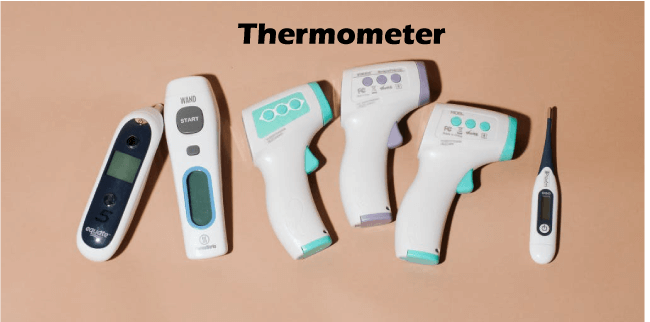
Properties of Thermometric LiquidThe thermometers typically include some liquids (usually mercury) to indicate the temperature of objects. Such a liquid is called a thermometric liquid. The liquid used in thermometers must have some basic properties, such as:
Note: Mercury is considered the best thermometric liquid due to the highest coefficient of expansion. This means that it remains in liquid form at most temperature levels. Therefore, it is used for measuring high temperatures. Furthermore, it does not stick to the thermometer's glass surface and has a luminous appearance, making the temperature readings clear.Types of ThermometerThermometers are available in a wide variety based on their specific requirements. As we discussed above, they mainly help measure the temperature of objects (living and non-living). Therefore, there is one particular set of thermometers that is used to measure body temperatures. In contrast, another set of thermometers is used to measure boiling point temperatures and freezing points in experiments or laboratory tests. Based on their needs, thermometers are broadly classified into the following two categories:
Let us discuss each type in detail: Clinical ThermometersClinical thermometers, also called medical thermometers, are particularly designed for clinical purposes. These thermometers are used to measure temperature in the human body. A basic clinical thermometer is made using a long narrow glass tube with a bulb containing mercury at its end. The mercury-level indicates the temperature of the human body. But mercury is a toxic element and can act as a poison. Therefore, these thermometers are replaced by modern thermometers that are digital and can measure the temperature without even touching the body. It is always recommended to sterilize these thermometers before use. The average temperature of the human body is 37 ˚C. This can fluctuate between 35 ˚C to 42 ˚C. Therefore, the clinical thermometers are designed with a temperature range of 35 ˚C to 42 ˚C. The following are different types of clinical thermometers that we use daily to measure body temperature: Digital ThermometerDigital thermometers typically operate using heat sensors, which help determine the temperature of the human body. Also, they contain an electronic circuit and a display screen to display the temperature readings. They can be used to record readings from under the tongue, under the armpit, or from the rectum. Digital thermometers are an advanced type of thermometers. These types of thermometers are considered the most accurate type of thermometers when used accurately. Furthermore, they are easy to use, inexpensive, and easily available. 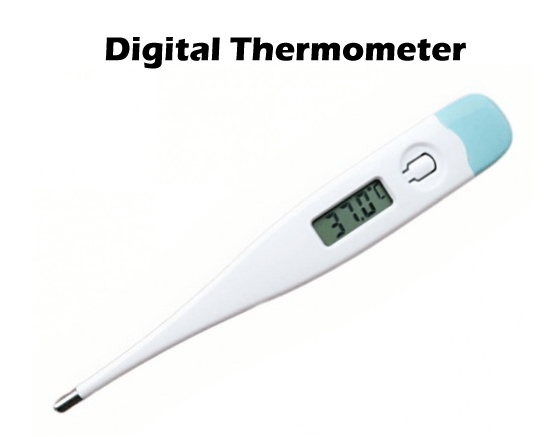
Electronic Ear ThermometerElectronic ear thermometers are designed to determine body temperature from inside the ear canal using infrared technology. Since they measure temperature using the tympanic membrane inside the ear, they are also known as tympanic thermometers. These thermometers are best suited for children. However, they are expensive and may not correctly measure the body temperature if the thermometer is not placed properly in the ear or there is too much wax inside the ear. Electronic ear thermometers measure the body temperature using infrared energy given off by the heat source. Therefore, these thermometers are quick to capture body temperatures. 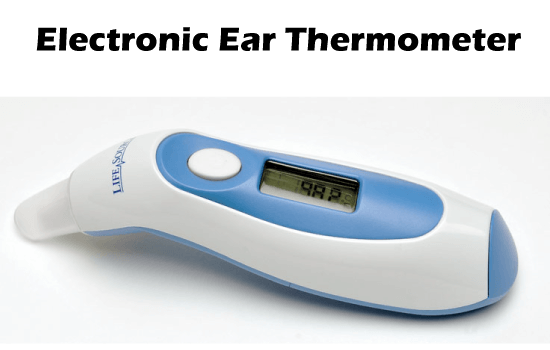
Forehead ThermometerJust like the electronic ear thermometers, the forehead thermometers also read heat using infrared technology. They capture the superficial temporal artery's temperature, a sub-branch of the carotid artery, using infrared sensors. These thermometers are modern and have become very popular in measuring people's temperatures in airports, stations, stores, and stadiums. The primary reason for their popularity is their non-contact behavior. This means forehead thermometers do not require physical contact while taking temperature readings. Forehead thermometers are also not accurate as traditional digital thermometers, and the temperature readings in these thermometers usually run around 1°F (0.6°C) cooler than the digital thermometers. 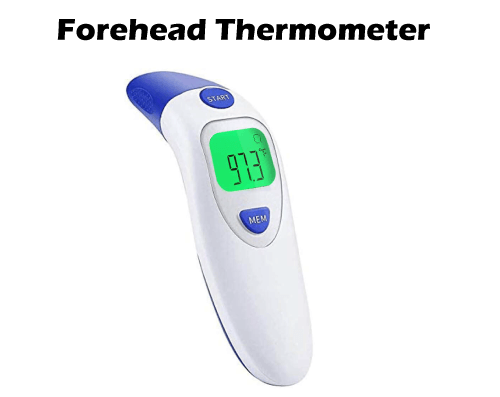
Pacifier ThermometerPacifier thermometers are primarily designed for babies older than three months. If a baby is comfortable using a pacifier, this can be the easiest way to determine the body temperature. Although pacifier thermometers are easy to use, they are not precisely accurate and capture approximate body temperatures. They need the baby to be still for a couple of minutes when measuring the body temperate, which can be a struggle. This can sometimes result in inaccurate temperature readings. 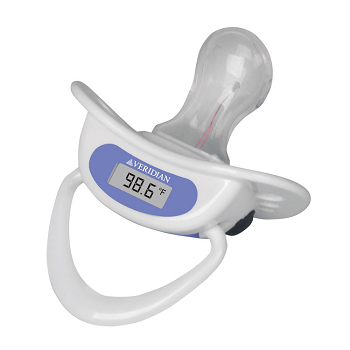
Plastic Strip ThermometerPlastic strip thermometers are not effective for measuring body temperatures as they do not provide exact temperature readings. These thermometers are more like tests than thermometers. They act as an indication that can help determine the presence of a fever in humans. We must put the strip on our forehead to use plastic strip thermometers, and the colors on the strip will change accordingly to the body temperature. If the color changes to danger, then there are chances of the presence of the fever. These thermometers cannot be trusted. Also, they are disposable single-phase thermometers. 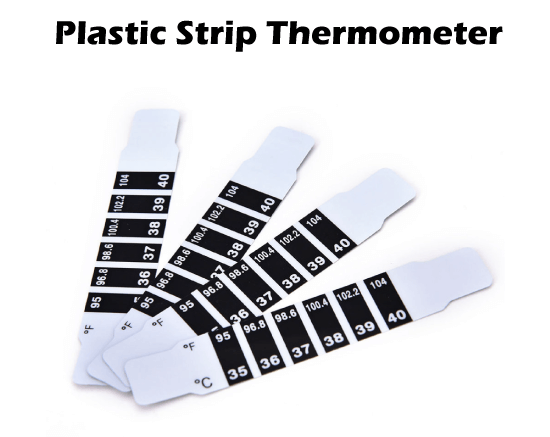
Mercury ThermometerMercury thermometers are the basic thermometers, and they were once the only option available to measure body temperature. They are the most accurate thermometers and used similarly to digital thermometers. However, these thermometers do not use any battery and have no electronic circuits or display. Mercury thermometers are made from a glass tube that has a various temperature reading on it. The mercury in liquid form is filled inside the glass at one end. When we put this thermometer under the tongue, the mercury starts rising according to the body temperature. Once the mercury stops, the corresponding reading is body temperature. However, mercury thermometers are no longer widely used due to safety concerns (mercury poisoning) and are illegal in some countries. 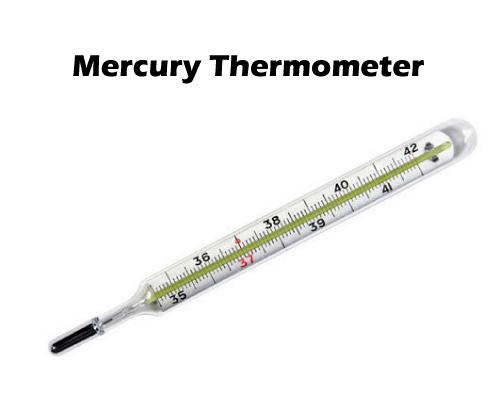
Laboratory ThermometersBecause we cannot use clinical thermometers for measuring temperatures other than a human body, and therefore, some specific thermometers are available for measuring temperatures for other purposes. More specifically, laboratory thermometers are the type of thermometer used to measure temperatures other than body temperatures. These thermometers are also sometimes known as lab thermometers. They help measure boiling points, freezing points, and many other objects' temperatures in labs or testing. Laboratory temperatures are purposely designed for lab purposes, and therefore, they should never be used for clinical or medical purposes. Besides, maximum-minimum thermometers help weather analyzers measure maximum and minimum temperatures at any specific location. Laboratory thermometers generally come with a temperature range of from - 10 ˚C to 110 ˚C. There is a wide range of laboratory thermometers depending on the variety of temperature measurements. The following are some of the most common types: Liquid-in-Glass ThermometerAs the name suggests, the liquid-in-glass thermometers are constructed using a sealed glass containing a liquid such as mercury or red alcohol. The volume of liquids in the thermometers changes according to the temperature. When the temperature increases, the liquid expands accordingly. This further helps indicate the temperature by the rinsing level of a liquid in the glass tube. Due to a glass tube, these thermometers are fragile. Therefore, they are mounted within protective housings with temperature readings printed on them. Furthermore, liquid-in-glass thermometers are handy, cheaper, and best suited for areas where there is an electrical problem as they do not require a power supply or a battery. 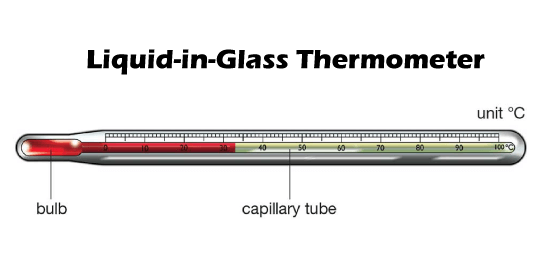
Bimetallic Strip ThermometerBimetallic strip thermometers are made by using two different metals. The metals are bonded so that they expand at different rates when they feel an increase in temperature. The two metals used in these thermometers also expand to different lengths. Therefore, the bimetallic strip typically bends or curls towards the relevant side with a lower thermal expansion coefficient. As soon as the bimetallic strip moves, it deflects a pointer over a calibrated scale which further helps determine the corresponding temperature. Moreover, bimetallic thermometers are rigid, inexpensive, easy to install and use. 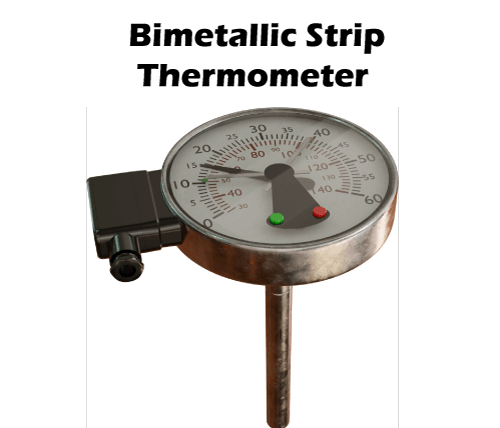
Thermocouple ThermometerThermocouple thermometers are made of electrical circuits surrounded by a box-shaped casing and two wires of different metals attached at the upper side's two ends. One wire-junction is placed on the object while the other one is placed at a constant lower temperature. Since both wire-junction are connected to a measuring instrument, the temperature difference forms an electromotive force, which is almost proportional to the difference in temperatures between both junctions. The measured temperature is displayed on the instrument. These thermometers are generally used to measure temperatures up to 2800 K. The thermocouple thermometers are also referred to as the thermal junction thermoelectric thermometer. 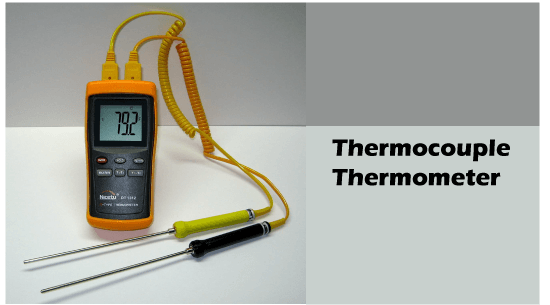
Pyrometer ThermometerPyrometer thermometers or pyrometers are remote-sensing devices that help capture temperatures of distant objects. These thermometers typically determine the object's temperatures based on the thermal radiation emitted by them. One of the main advantages of these thermometers is that there is no need to touch objects. Therefore, pyrometers are best suited for measuring the temperatures of moving objects or surfaces. Moreover, they are also helpful in measuring those objects' temperatures that cannot be touched due to their complex structure or the higher temperatures. Pyrometers are generally used to measure temperatures greater than 2000 K. 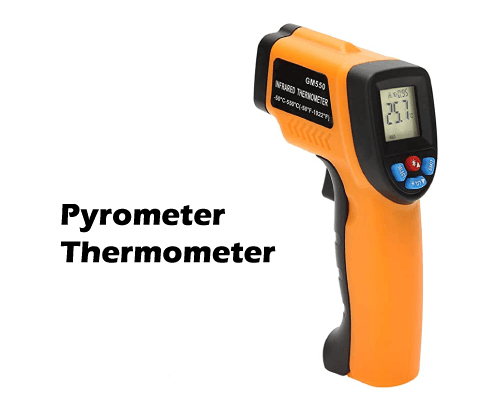
Platinum Resistance ThermometerPlatinum resistance thermometers typically measure the temperature by using a platinum wire. The wire is connected to an electrical resistance that changes based on the nearest temperature. This means the resistance of the material used in these thermometers increases with the increase in temperature. Platinum resistance temperatures are mainly designed to determine the outside temperatures. Although the temperature accuracy is quite good, these thermometers are a bit slow. These types of thermometers are generally used to measure temperatures in the ranges between 500 K to 2300 K. 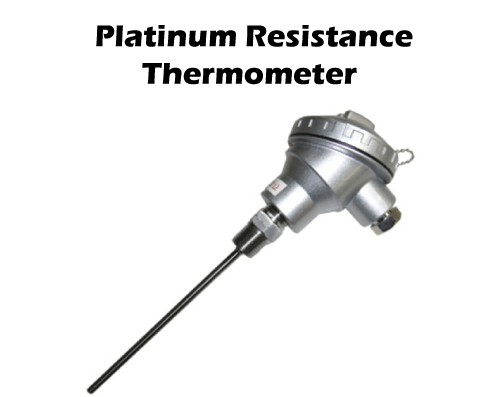
Probe ThermometerProbe thermometers are one of the most common and widely used types of thermometers. They are mainly used to take instant temperature readings of foods and liquids samples. These thermometers' instant temperature readings make them ideal for the catering trade for hygiene testing in retail outlets and laboratories. Probe thermometers typically contain a pointed tip that helps these thermometers in penetration and immersion. Probes are available in two types, such as the fixed probes and the wired probes thermometers. 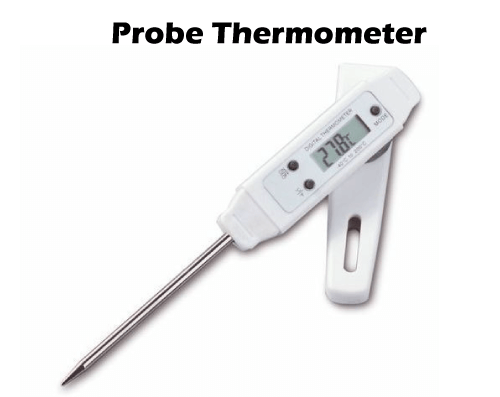
Which type of thermometer is most accurate for measuring body temperature?Choosing the best and most accurate thermometer is always very important. A thermometer that we can use comfortably is usually the best one. However, digital thermometers are always preferred over other thermometers by many medical professionals when it comes to accuracy. It is crucial to use the thermometer properly; otherwise, the reading might not be correct. The temperature readings usually vary for the same thermometers based on how and where it is used. The digital thermometers can measure body temperature from under the tongue (oral temperature), the armpit, or the rectum. While rectum readings are considered the most accurate for babies and children, the oral readings are very reliable for other age groups.
Next TopicTypes of Transformer
|
 For Videos Join Our Youtube Channel: Join Now
For Videos Join Our Youtube Channel: Join Now
Feedback
- Send your Feedback to [email protected]
Help Others, Please Share










